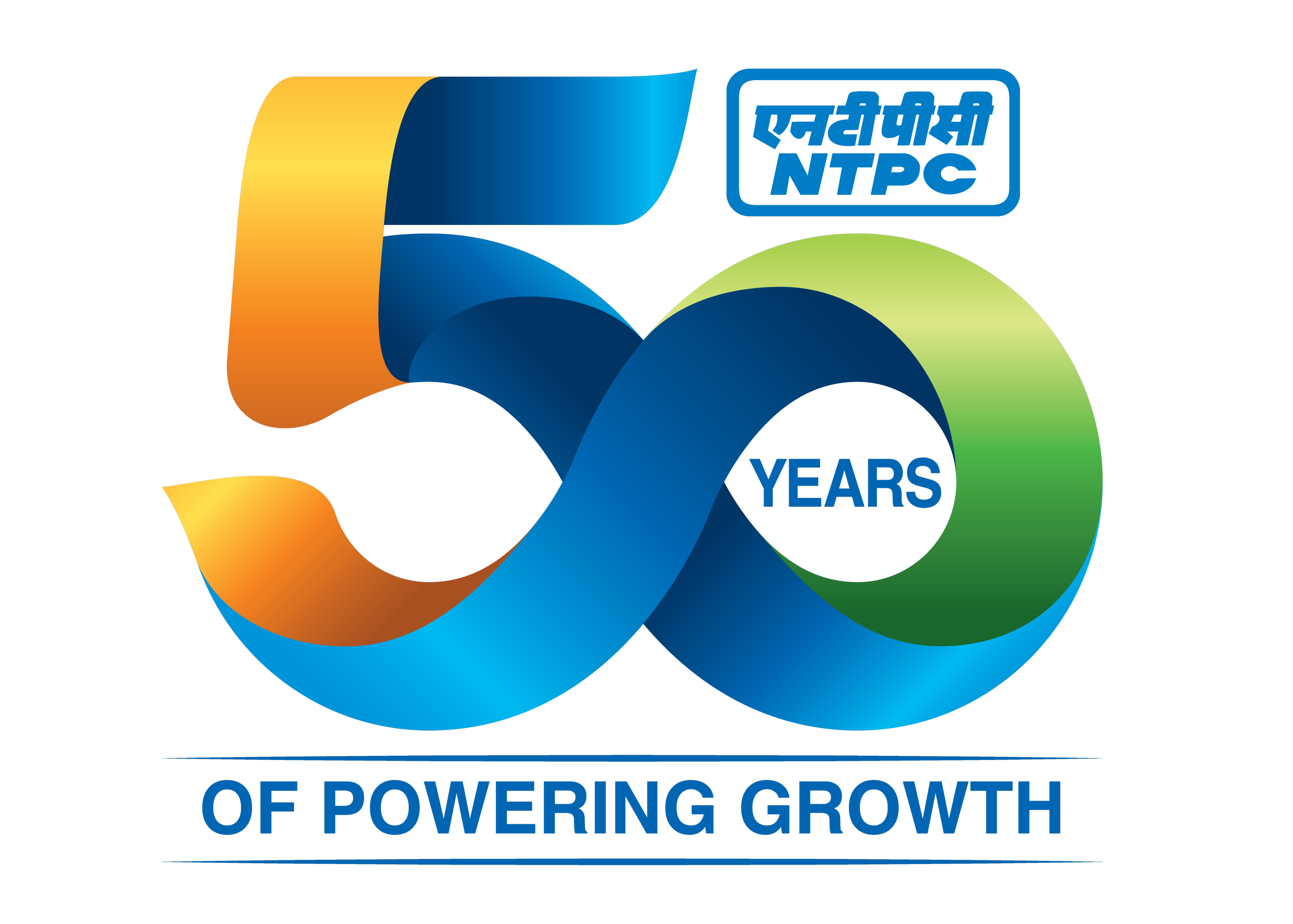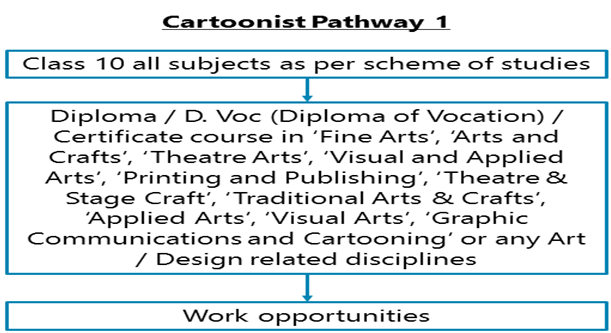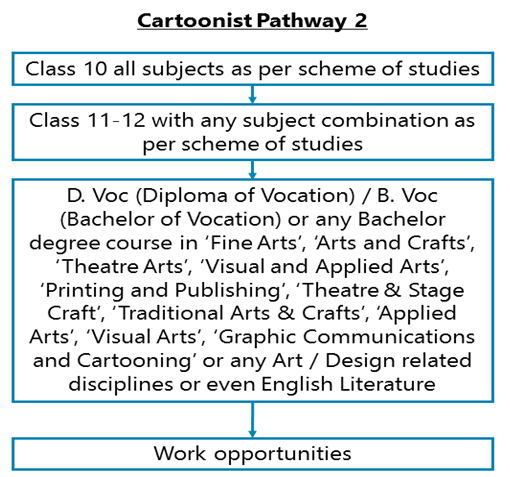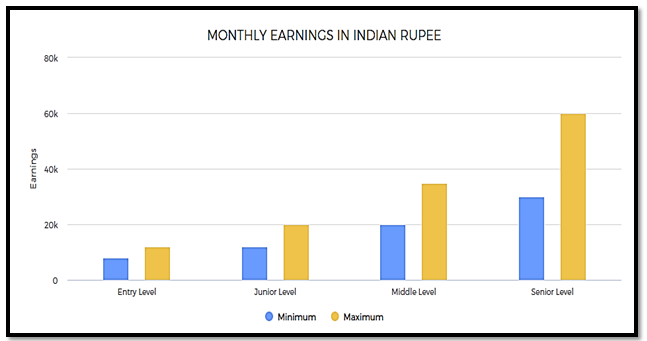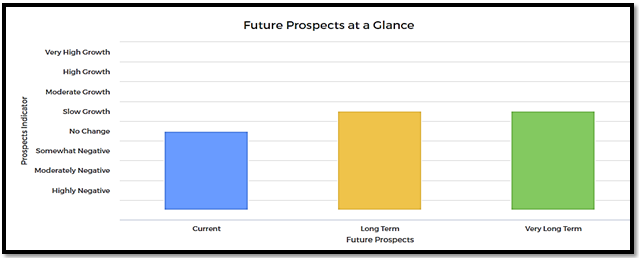Cartoonist
Entry Level Qualification
10
Career Fields
Arts & Design
For Specially Abled







About Career
1. As a professional Cartoonist, you will be working manually or on a computer to draw cartoons as well as create cartoon animations for comic books, newspapers, magazines, graphic novels, children’s books, films, advertisements, social networks etc.
2. A professional cartoonist must be good at story telling as it is through his pictures that a story is portrayed. Cartoons can be created in different forms such as with pen, pencil, charcoal, inks and computer software. A cartoonist must be able to narrate the story through their cartoons and writing such that people of all ages can easily understand. A cartoonist has to follow the story board provided to him to create characters and their movements to tell a story. A cartoonist works for advertising agencies to create characters for their ads. They can also work for book publishing agencies, with production houses that create animated movies and also newspapers to create cartoon strips. A cartoonist can be self- employed and work on contractual basis.
3. Think of Chhota Bheem, the dhoti wearing boy of Dholakpur! He is the biggest and most successful cartoon creation in the children’s animation business category of India and is still going strong after 11 years.
4. Cartoonists are very good at drawing, have a great sense of humour and have deep interests in related matters like painting, colouringetc! You also have to be good with words as you, most often, have to tell a story to explain your images.
5. You have to be creative, innovative and most importantly aware of common facts about the society, general affairs and current events for building effective and attractive cartoon characters, digital comics or cartoon strips. You may also create cartoon images as a substitute for written or spoken messages conveying the same meaning for which you need to understand human emotions and concepts and express it in a humorous way. Your creations may be published on paper or online or both.
PARTICULARS | DESCRIPTION |
Name | Cartoonist |
Purpose | Creating & Preparing Model Drawings |
Career Field | Arts & Design |
Required Entrance Exam | UCEED, CEED, AIEED |
Average Salary | 150000 - 300000 Rs. Per Year |
Companies For You | Disney, Nickelodeon, Mad Magazine & Many More |
Who is Eligible | Class 10th Pass |
Key Roles and Responsibilities
As a Cartoonist, you will be involved in following key roles and responsibilities:-
1. Creating and preparing model drawings and sketches of cartoon characters, by providing details from memory, manufactured products, live models, photographs or other reference materials.
2. Using a variety of instruments and methods involving pen and ink, charcoal, watercolors, oil paints, laser printers, computer software, callipers (a type of measuring instrument), fountain pens, paint sprayers etc. to build your designs and characters.
3. Integrating and developing visual elements, like space, line, colour, mass, and perspective, for producing the desired effects to convey emotions, ideas, or moods.
4. Studying different related techniques/technologies and learning how to apply them to your artwork and design endeavors for making them more effective in capturing additional attention and interests of your audience.
5. Photographing objects, images, or human faces at public spaces for using the photographs as reference material.
6. Interacting with your colleagues and clients to understand scripts and creative ideas.
7. Maintaining portfolios of your artistic works as a demonstration of your interests, styles and abilities.
8. Marketing your artwork through mailings, brochures or on Websites.
9. Setting up exhibitions of your artwork, creations and illustrations for sale/display or submitting your artwork to various art galleries or shows.
Career Entry Pathway
Class 10 all subjects as per scheme of studies – Diploma / D. Voc / Certificate in ‘Fine Arts’ or any Art / Design related disciplines
After Class 10, you can go for a Diploma / D. Voc (Diploma of Vocation) / Certificate course in ‘Fine Arts’, ‘Arts and Crafts’, ‘Theatre Arts’, ‘Visual and Applied Arts’, ‘Printing and Publishing’, ‘Theatre & Stage Craft’, ‘Traditional Arts & Crafts’, ‘Applied Arts’, ‘Visual Arts’, ‘Graphic Communications and Cartooning’ or any Art / Design related disciplines. You need to maintain a portfolio of your artistic works as a demonstration of your interests, styles and abilities.
Class 10 all subjects as per scheme of studies - Class 11-12 with any subject combination as per scheme of studies – Diploma / D. Voc / B. Voc or any Bachelor degree course in ‘Fine Arts’ or any Art / Design related disciplines
After Class 11-12, you can go for a D. Voc (Diploma of Vocation) / B. Voc (Bachelor of Vocation) or any Bachelor degree course in ‘Fine Arts’, ‘Arts and Crafts’, ‘Theatre Arts’, ‘Visual and Applied Arts’, ‘Printing and Publishing’, ‘Theatre & Stage Craft’, ‘Traditional Arts & Crafts’, ‘Applied Arts’, ‘Visual Arts’, ‘Graphic Communications and Cartooning’ or any Art / Design related disciplines or even English Literature. You need to maintain a portfolio of your artistic works as a demonstration of your interests, styles and abilities.
Class 10 all subjects as per scheme of studies - Class 11-12 with any subject combination as per scheme of studies – Bachelor degree in any discipline
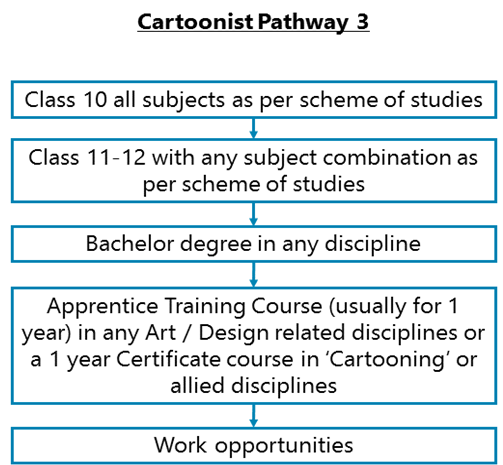
After Class 11-12, you can finish your Bachelor degree in any discipline. Then you may go for an Apprentice Training Course (usually for 1 year) in any Art / Design related disciplines or a 1 year Certificate course in ‘Cartooning’ or allied disciplines offered by various institutes across the country. You need to maintain a portfolio of your artistic works as a demonstration of your interests, styles and abilities.
Required Qualification & Competencies
1. After Class 10, you can either go for Diploma / D. Voc / Certificate courses or complete class 11-12.
2. After Class 11-12, you can go for Diploma / D. Voc / B. Voc or any Bachelor degree courses in any Art / Design related disciplines or any other fields.
3. Various private/public vocational training establishments across India offer courses on ‘Cartooning’ or related disciplines.
MINIMUM EDUCATION REQUIRED | MAXIMUM EDUCATION REQUIRED |
Post-Secondary Certificate / Diploma Programs for which the minimum eligibility is a pass in class X. | Under Graduate Undergraduate Degree / Honours Diploma / Graduate Diploma (equivalent to a Degree) Programs for which the minimum eligibility is a pass in Higher Secondary / Class XII School Leaving examination. |
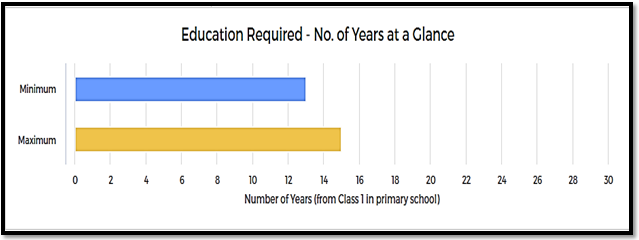
Competencies Required
1. You should have interests for Artistic Occupations. Artistic occupations mostly involve working with creative ideas, art, and designs. These occupations involve abstract or conceptual thinking, creative self-expression and often do not follow any set processes or rules for getting things done.
2. You should have interests for Conventional Occupations. Conventional occupations involve repetitive and routine tasks as well as fixed processes or procedures for getting things done. These occupations involve working more with data, systems, and procedures and less with ideas or creativity.
3. You should have interests for Social Occupations. Social occupations involve helping or assisting others; these involve working with and communicating with people to provide various services; these may involve educating and advising others.
4. You should have knowledge of Applied Arts - Knowledge about the theories and techniques required for producing various works of applied and commercial arts such as craft, floral design, landscape design, surface design, lighting design, etc.
5. You should have knowledge of Fine Arts - Knowledge about the theories and techniques required for producing various works of fine arts such as painting, drawing, illustration, sculpture, digital art, installation art, craft, visual art, etc.
6. You should have Active Learning Skills - Focused and continuous learning from various sources of information, observation and otherwise for application in getting work done.
7. You should have Critical Thinking Skills - the analysis of complex situations, using logic and reasoning to understand the situations and take appropriate actions or make interpretations and inferences.
8. You should have Time Management Skills - prioritizing work, managing time effectively.
9. You should have Fluency of Ideas - The ability to come up with a number of ideas about a topic (the number of ideas is important, not their quality, correctness, or creativity).
10. You should have Visualization Ability - The ability to imagine how something will look after it is moved around or when its parts are moved or rearranged.
11. You should have Near Vision - The ability to see details at close range (within a few feet of the observer).
12. You may require prior knowledge of computer software or programming languages which will help you interact with IT developers to explain your art concepts to them. These technologies include React Native, Autodesk, Adobe Illustrator, Adobe AfterEffects, JavaScript, Adobe Dreamweaver, Adobe Flash etc.
13. You are always imaginative or in most situations.
14. You can always act independently or could do so in most situations.
15. You are always friendly and outgoing; you love to be in the company of people always or most of the times.
16. You are fun-loving; you enjoy interacting with people and enjoy yourself.
17. You are always or mostly caring, supportive, sympathetic and kind to others.
Career - Job Opportunities & Profiles
You may get work opportunities as:
1. Caricature Artist/ Illustrator
2. Cartoonist
3. Animation Designers – Sketching and Fine Arts
4. Artist – Visual Design
5. Sketcher/ Digital Colouring Artist
6. Freelance Artist
7. Comic Book Illustrator
You may get various opportunities to create your artworks for:
1. Newspapers
2. Magazines
3. Comic Book publications
4. Graphic Novels
5. Children’s books, songs and rhymes
6. Posters
7. Web-Series
8. Publishing Companies
9. Animation Studios
10. Television Channels broadcasting children’s cartoons
Specialisation Tracks In this Career
1. Reality Cartoonist
As a Reality Cartoonist, your creations will be mainly derived from the emotional reactions of humans so that every person can somehow relate to the message. Thoughts like ‘Isn’t life like that?’ or ‘That’s an experience I’ve had already!’ or ‘Oh that’s how it works!’ come to your mind when you look at a reality-based cartoon. Your handiworks may be simple caricatures (a picture of a person drawn to create a comical effect) or related to subjects like the political ecosystem in the country, the world of movies etc.
2. Fantasy Cartoonist
As a Fantasy Cartoonist, your artworks will be fantasy-themed without any connection with worldly experiences and reality whatsoever. The primary purpose of your creations will be to generate laughter for e.g. you may draw pigs flying or dinosaurs sitting at a computer or a hungry tiger shopping at a supermarket! There is no essential subject matter to your handiworks except that it may tell an interesting but unreal story of fictional characters! Your creations may be used for video games, animation, toys etc.
Career Growth
1. You can grow to be a Senior Creative Artist, Senior Concept Artist Chief Illustrator, etc. after substantial work experience.
2. You can gain a lot of fame through open contests and exhibitions and later create your own art gallery maybe.
3. You may grow as a freelancer and serve a clientele with renowned publication agencies or digital advertising groups etc.
4. You may also serve as a teacher for some years and then form your own art school too!
Salary Offered
1. At the entry level, with 4-5 years of work experience, you may expect between Rs. 12,000 –25,000 or more per month.
2. After having 6-10 years of work experience, you may expect between Rs. 20,000 – 35,000 per month or even more.
3. There is a huge demand abroad for trained and skilled Creative Artists, Caricature Artists, Sketchers etc. from India, with solid experience in ‘Cartooning’, in countries like Canada, Australia etc.
Monthly Earning In Indian Rupee
Entry Level | Junior Level | Mid-Level | Senior Level | |||||
Min Earning | Max Earning | Min Earning | Max Earning | Min Earning | Max Earning | Min Earning | Max Earning | |
8000 | 12000 | 12000 | 20000 | 20000 | 35000 | 30000 | 60000 | |
1. Entry level: 0 - 2 years of work experience
2. Junior Level: From 1 to 12 years of work experience
3. Mid-Level: From 5 to 20+ years of work experience
4. Senior Level: From 10 to 25+ years of work experience (there could be exceptions in some high-end technical, financial, engineering, creative, management, sports, and other careers; also in the near future, people will reach these levels much faster in many careers and in some careers, these levels will have no meaning as those careers will be completely tech skill driven such as even now, there is almost no level in a Cyber Security Expert’s job)
Work Activities
1. Creative thinking - Developing new ideas, concepts, innovative solutions to problems, newer ways of getting things done, designing products and services, creating work of art and craft, etc.
2. Getting Information and learning - Observing, hearing, and reading using computers, or otherwise obtaining information and learning from it.
3. Organizing, planning and prioritizing tasks - Planning and organizing tasks in order to achieve work goals; prioritizing tasks to achieve goals and making the best use of the time available.
4. Identifying objects, actions, and events - Identifying various characteristics of objects; observing and understanding actions and events; understanding changes in actions and events.
5. Assessing and evaluating quality- Assessing and evaluating the quality of materials, systems, processes, products, services, etc.
6. Communicating with co-workers and others– Communicating with people in writing, verbally or otherwise inside your workplace and various other people who have professional relationships with your place of work.
7. Presenting and demonstrating work to others – you will need to present and demonstrate your work to others such as clients, co-workers, and superiors.
8. Working in a team - Working in a multi-disciplinary team of people; developing a team; maintaining professional relationships among team members.
Future Prospects
1. This pathway is expected to show moderate to decent future growth. Its time India develops its own comic empire! The growth in the sub-sectors of the Indian Media and Entertainment Industry showed substantial growth. The Television industry is expected to grow in terms of employment volume to 0.64 million from 0.28 million in 2017, translating to a human resource requirement of 0.36 million.
2. The Print Media industry is expected to grow in terms of employment volume to 0.13million from 0.07million in 2017, translating to a human resource requirement of 0.06million. The overall industry growth of Media and Entertainment Sector has been estimated at a rate of 13.10% compounded annually to touch the mark of 39.68 billion US Dollars from 22.28 billion US Dollars in 2018. India’s media consumption has been growing at an alarming rate of 9% in the period 2012-2018 compounded annually. This is 9 times that in the US and 2 times that in China. Revenues from the Advertising sector are forecasted to reach 18.39 billion US Dollars from 9.44 billion US Dollars in 2018. Digital Advertising industry in India is expected to grow at a rate of 32% compounded annually to touch the mark of 2.93 billion US Dollars.
Future Prospects At A Glance
Current (0-1 year) | Long Term (2-5 year) | Very Long Term (6-10 years) |
No Change | Slow Growth | Slow Growth |
